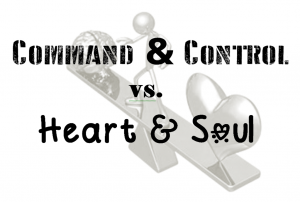Leaders: Command & Control or Heart & Soul?
In order to lead, you must be authoritative and absolutely in charge at all times. That's a dangerous myth that derails would-be leaders and prevents them from becoming the type of leader that others willingly and eagerly follow.
Images abound of the classic command-and-control leader. Think Jack Nicholson as Colonel Nathan Jessep in the movie, A Few Good Men ("You want the truth? You can't handle the truth!"). Think dictators throughout history. The Godfather. Leona Helmsley (nicknamed the "Queen of Mean" for her tyrannical behaviors).
Despite these negative perceptions about despotic leaders, many continue to associate the word "leader" with this type of behavior. Nothing could be farther from the truth.
To be a leader, you must behave in ways that cause others to follow you. Your title or position of authority may compel others to do what you say (when you're looking). But fear, intimidation, micro-managing and "because I say so" directives will never earn you loyal followers who will back you up when the going gets tough.
Real leaders -- the ones who have willing followers -- rely on a different approach. They don't need command-and-control tactics or coercion to get results. Instead, they choose behaviors that are proven to make leaders more effective, behaviors that result in higher levels of employee engagement and, in turn, result in much stronger business outcomes.
Research provides a clear and irrefutable case for these behaviors. The Leadership Challenge, a book and body of work by Jim Kouzes and Barry Posner, is based on research with over 5 million people who have provided information about the behaviors of leaders. From this work, we know exactly how exemplary leaders conduct themselves. We have a behavior-based blueprint for leadership.
Some might describe the 30 behaviors of exemplary leaders as "soft skills." Since leadership behaviors are all about relationships and connecting with followers, this might be an apt description. But don't let a term like "soft skills" deceive you -- the impact of these behaviors is solid: improved retention, improved customer satisfaction, improved profit margins...
Many are skeptical that a heart-and-soul approach can drive a business forward. That's because the command-and-control behaviors yield obvious and observable results in the moment. She sternly said it, and he quickly did it. Cause and effect.
But at what cost? Is merely getting stuff done the hallmark of a leader? The determinant of company success?
Not likely. For people to stay engaged and commit themselves to the long-term, more is needed. No paycheck is big enough to continually be treated like a cog in the wheel. Long-term success requires leadership that causes people to "want to struggle for shared aspirations" (Kouzes/Posner).
To lead with a heart-and-soul approach, you have to give up command-and-control. They can't co-exist. Counterintuitive though it may be, you will become more effective as a leader when you give up that authority that comes from position or title.
 The CONNECT2Lead Blog and training programs are products of People First Productivity Solutions. We build organizational strength by putting people first. If you’d like to read more this month about Dangerous Myths that Derail Leaders, subscribe to our weekly CONNECT2Lead Newsletter for special offers, content, and blog posts.
The CONNECT2Lead Blog and training programs are products of People First Productivity Solutions. We build organizational strength by putting people first. If you’d like to read more this month about Dangerous Myths that Derail Leaders, subscribe to our weekly CONNECT2Lead Newsletter for special offers, content, and blog posts.

